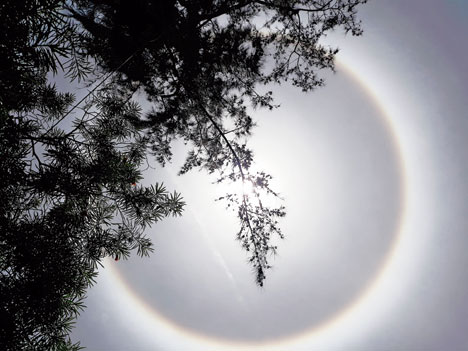
A rainbow-like ring encircled the sun for more than an hour until noon on Wednesday, leaving many people marvelling at a sight they hadn’t witnessed before and possibly knew little about.
Known as the 22-degree halo, the atmospheric phenomenon was caused by the rays of the sun getting deflected through hexagonal ice crystals present in cirrus clouds, according to Debiprosad Duari, the director (research and academic) of the MP Birla Planetarium.
Cirrus clouds, visible as stray wisps in the sky, are formed when water vapour freezes into ice crystals at altitudes of five to 10km from the earth’s surface. “The 22-degree halo is so called because the angular distance of the light ring is exactly 22 degrees from the sun at the centre,” said Duari, who shared a picture (right) that he had shot with Metro.
Mobile-phone pictures of the celestial surprise, visible from 10.45am to noon, went viral on social media. “Go out guys & watch it.. what a splendid view ..it seems an alien ship is going to land here in #Kolkata,” said a Facebook post.
Subrata Chakrabarty, a 43-year-old IT worker with a passion for stargazing, was among the few who understood what was happening. “It was more beautiful than anything I could have imagined. I showed it (a picture) to all my colleagues and called up family members to tell them to take a look,” he said.
When sunlight falls on hexagonal ice crystals, refraction occurs. As a result, a bright ring of light forms around the sun. Since the passage of sunlight through millions of these crystals causes the white light to get dispersed in all the colours of the rainbow, one often sees, as was the case on Wednesday, a halo with a reddish tinge on the inside and a bluish one on the outer ring.
“Since sunlight gets refracted or bent by at least 22 degrees, when observed closely, the inner part of the halo looks a little darker than other parts of the sky,” Duari explained. “The 22-degree halo is a local phenomenon whose duration depends on the cloud formations and the air currents.”










